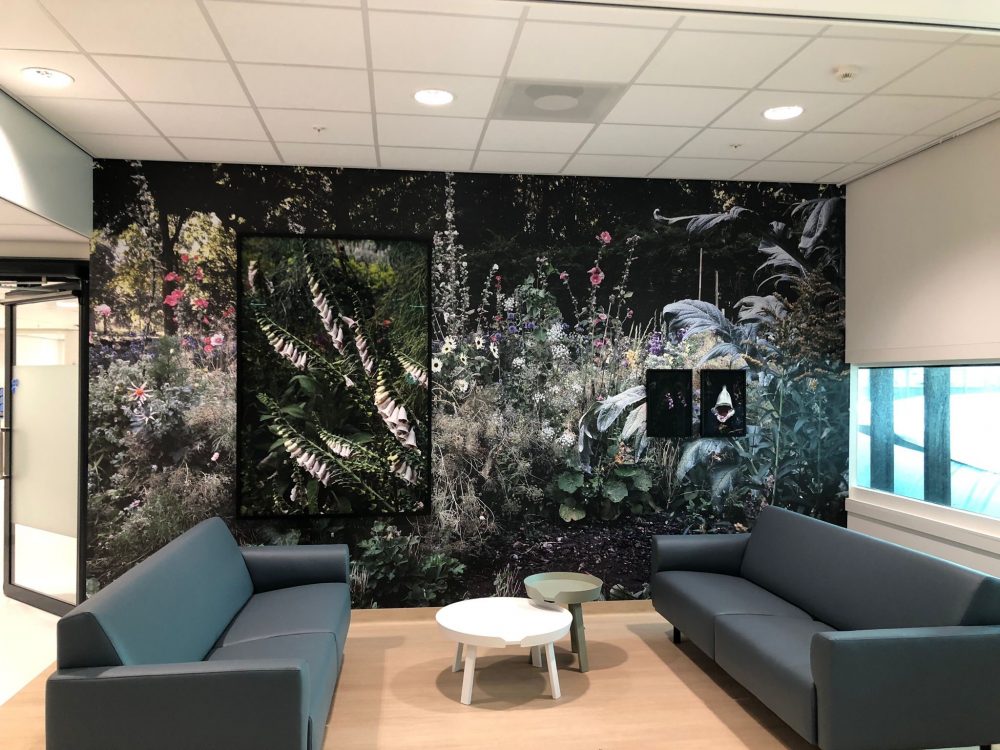Amsterdam UMC assignment policy
This series is about commissioning and public space. A situation is always sketched from the perspective of the narrator. This can be an artist and/or a client. We want to sketch a picture of the practice of artists: what goes well, what does an artist encounter when working in public space and how does a commissioner work? Our hope is that everyone can benefit from the information and at the same time get to know and understand the perspective of 'the other' better. This time about the commissioning policy of Amsterdam UMC.

Recently, the first of six Flowerwalls by artist Elspeth Diederix at the Amsterdam UMC (University Medical Center), are photo walls featuring portraits of plants that form the basis of the medications used by the relevant departments. This prompted me to talk to Sabrina Kamstra, head of the art department there, and delve into the extensive collection of Amsterdam UMC and their commissioning policy.
An active art commission policy linked to remodeling or new construction of the hospital
Thanks to loans from private collectors and with the help of the so-called 1% scheme, the basis for the art collection was laid in the early 1980s. Initially, the hospital acquired mainly Dutch painting from a recent past: the 1950s, 1960s and 1970s. The Cobra, Matter Art, Zero Art and New Figuration periods are well represented, for example. Slowly but surely the emphasis has shifted to contemporary visual art. Some fifty works of art are acquired each year.
In addition, there is an active art commission policy linked to renovations or new construction of the hospital. "I want a building that breathes art" says Kamstra, that is what drives her; the right art in the right place. With the goal of creating a pleasant environment with good and high-profile commissioned art, fitting in with the collection. No new building, renovation or refurbishment without a link to the visual arts, if it were up to Kamstra. And so far she has succeeded excellently. Together we walked around the hospital and along the way we came across several works of art. In this article I will focus on two of them, the recent work by Elspeth Diederix and a work by Herman Lamers.
Flowerwalls
In the Erasmuspark Amsterdam West, Diederix developed a flower garden called The Miracle Garden. It is a total work of art and the breeding ground for the so-called Miracle Series; special works of art that emerge from the garden and are periodically displayed on billboards throughout the city and The Parole appear. In addition, the garden is freely accessible to the public and open daily. The most wonderful flowers bloom there throughout the year. For the photo walls in the Amsterdam UMC she lets medicinal plants grow there and then photographs them.

Back in 2018, so well before the first photo wall was installed, Kunstzaken and Diederix won the Elisabeth van Thüringen Prize, a triennial incentive prize for art commissions in healthcare, with this plan. The jury praised "the high and continuous quality of the art projects in the Amsterdam UMC, of which the art project Flowerwalls is a representation".
The medicinal plants are already growing and waiting to be photographed
The first Flowerwall was placed in the new Cardiology nursing unit. Art Matters put Diederix in touch with Reinier van Hest, the hospital's pharmacist, so they could get into The Miracle Garden could grow the right plants. That is, plants that are the basis of medicines used in the Cardiology Department. That was not easy, because the plants must not only be scientifically correct but also thrive in the Dutch climate. Diederix photographed foxglove and lily of the valley for this department. Both contain digoxin, a drug against heart failure, among other things. In the coming years, the other nursing wards will be completed. Flowerwalls be realized, the selected medicinal plants for this are already growing in The Miracle Garden and wait for the moment when they can be photographed.
Library
In 2010 Marcel Levi became chairman of the Board of Directors of the AMC (now merged with VU Medical Center and since then called Amsterdam UMC). The courtyard near the office of the Board of Directors was not the reception area he had in mind. Artist Herman Lamers was asked by Kunstzaken to create an installation so that the plaza could become a meeting place. In 2013, Lamers delivered an interplay of four glass portrait busts on bamboo pedestals and two "google screens" made of MDF: a digital version of libraries, based on the design of "Google Images. Through those screens, visitors see four human heads as if they too had materialized from a virtual world. Come closer, the glass appears coarse, like a pixelated photograph, and the recognizable faces dissolve into abstraction. Lamers found this to be illustrative of the technological human image of a hospital. The accompanying lighting plan was created in close coordination between Lamers and Atelier LEK: during the day, the abundant daylight transforms the space through the changing Dutch skies and seasons; at night, the artificial light changes intensity, creating a completely different space.
I didn't check, but this work by Herman Lamers is of such stunning beauty that it can't help but have exceeded all of the board chairman's expectations.
In conclusion
Clearly, Amsterdam UMC cares about art and has an exciting, high quality commission policy. It may feel a bit awkward to wander through a hospital to view works of art when you don't have to be there for any other reason, but it could be quite possible in my experience. And otherwise, you can wander on the extensive website that lists all the art commissions provided.


